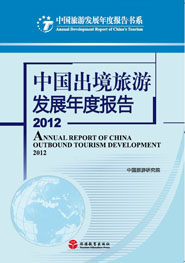Annual Report of China Outbound Tourism Development 2012

Annual Report of China Outbound Tourism Development 2012
Contents
Introduction overview of china outbound tourism development in 2011
1 Continuous improvement of the environments at home and abroad
1.1 Constant development of china’s economy as a major driver of fast growing
outbound tourism
1.2 Significance of china’s outbound tourism to the world tourism economy
1.3 Resources allocation by businesses to outbound tourism services
1.4 Strengthened international co-operation
1.5 Improved tourism public services
2 The establishment of the world’s number one outbound tourism market
2.1 Fast growing outbound tourism
2.2 Increased adverse balance of tourism service trade
2.3 Diversified outbound tourist destinations
2.4 Potentials of regional outbound tourism
3 Diversified consumption motivations
3.1 Total consumption spending driven by tourism related-shopping
3.2 Leisure resorts
3.3 In-depth and theme tourism products
3.4 Budget travels in demand
3.5 Declining consumer satisfaction
4 Industry transformation and upgrades driven by the market growth
4.1 Transformation from a quantity-driven pattern to a quality-oriented approach
4.2 Growing regional travel whole-sellers
4.3 Integration of retail and wholesale business by private travel operators
4.4 More open to the outside world
5 Influencing the world and changing China
5.1 China’s outbound tourism –a global economic growth pole
5.2 Enhancing incremental influence of China’s tourism industry
Chapter 1 Environmental analysis of China outbound tourism market in 2011
Section Ⅰ:Major determinants of outbound tourism of China
Section Ⅱ: Identification of key drivers and selection of analytical models
2.1 External determinants
2.2 Model selection and its rationale
Section Ⅲ : Economic significance of outbound tourism in 2011
3.1 Growth of economic output and per capita income
3.2 Increased purchasing power driven by the “Yuan devaluation domestic and its appreciation abroad”
3.3 High-speed rail network upgrades
3.4 Impact of fluctuation oil prices
3.5 Significant growth in domestic tourism
3.6 Overseas payment platforms expansion
Section Ⅳ : Political environment
4.1 Betterment of the diplomatic, economic and political environments
4.2 Eased visa restrictions
4.3 Significant effects of the ECTA on the growth in the tours to Taiwan, China
Section Ⅴ :Other market environment features
5.1 Intensified marketing promotion by destination countries in China
5.2 Greater attention to the travel security
5.3 Improved market regulation and mounting pressures
Chapter 2 Market structure and consumption characteristics of China outbound tourism in 2011
Section Ⅰ: Market structure
1.1 Market situation
1.2 Market structure
Section Ⅱ: Overall analysis
2.1 Variables in outbound tourists’ consumption
2.2Demographic characteristics of Chinese mainland outbound tourists
2.3 Factors affecting outbound tourist consumption decisions
2.4 Consumption decision characteristics of outbound tourists
2.5 Characteristics of outbound tourists consumption pattern
2.6 Future consumption intention of outbound tourists
Section Ⅲ : Market segmentation
3.1 Analysis of outbound travel for business purpose
3.2 Analysis of outbound travel for vacation
Section Ⅳ : consumption characteristics of major destinations
4.1 Hong Kong SAR
4.2 Macao SAR
4.3 Taiwan, China
4.4 Japan
4.5 USA
4.6 Australia
4.7 South Africa
Section Ⅴ :Analysis of outbound tourists’ satisfaction
5.1 Statistical analysis of tourists’ satisfaction
5.2 Integral satisfaction and quality perception index
Chapter 3 Operational characteristics of China outbound tourism industry in 2011
Section Ⅰ: Fundamentals of outbound tourism industrial players
1.1 Continuous development of the industry scale and players’ power
1.2 Open market boosts tourism development
1.3 International cooperation entered a new stage
1.4 The rise of regional wholesalers in port cities
Section Ⅱ: Operating situation of outbound tourism industry
2.1 Online tourism and cross-industrial performance
2.2 Online media: the new battle field
2.3 Market demand leads to industrial performance
2.4 The appreciation of RMB requires international cooperation
Section Ⅲ : Product development and innovation of major outbound tour operators
3.1 High-end, in-depth tourism products are rising stars
3.2 Customized travel service as a new theme
Chapter 4 The characteristics of regional outbound tourism development
Section Ⅰ: North China Market
1.1 Development of outbound tourism
1.2 Case study—Beijing
Section Ⅱ : East China Market
2.1 Development of outbound tourism
2.2 Case study—Shanghai
Section Ⅲ : South China Market
3.1 Development of outbound tourism
3.2 Case study—Guangzhou
Section Ⅳ : Southwest China Market
4.1 Development of outbound tourism
4.2 Case study—Chongqing
4.3 Case study—Chengdu
Section Ⅴ :A comparison of five typical cities in outbound market
5.1 Demographic characteristics of outbound tourists
5.2 Factors influencing consumer decision-making
5.3 Consumption decision characteristics of outbound tourists
5.4 Characteristics of outbound tourist consumption patterns
Chapter 5 Development trends and recommendations for China’s
outbound tourism in 2012
Section Ⅰ: Development trends for outbound tourism in 2012
1.1 Optimizing environment of outbound tourism development
1.2 Development of consumption patterns promotes industrial upgrade
1.3 China’s outbound tourism changes world tourism landscape
Section Ⅱ: Proposals for China’s outbound tourism development
2.1 Governmental authorities should make a systematic mechanism
2.2 Foreign destinations should focus on service enhancement
2.3 Tourism corporations should be prepared for changes
Editorial Staff
